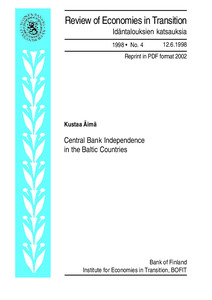Central bank independence in the Baltic countries
Äimä, Kustaa (12.06.1998)
Numero
4/1998Julkaisija
Suomen PankkiBank of Finland
1998
Julkaisun pysyvä osoite on
https://urn.fi/URN:NBN:fi:bof-201408113021Tiivistelmä
The aim of this article is to establish the level of independence that each of the Estonian, Latvian and Lithuanian central banks enjoy according to law and in practice.The rationale behind this is the well-known both empirically and theoretically verified relationship between central bank independence (CBI) and inflation rate arising from the increased monetary policy credibility that is possible to obtain by strengthening the position of the central bank (CB).In this paper two different indices of central bank independence are used to measure the level of legal CBI of the Baltic central banks, namely Grilli - Masciandro - Tabellini (1991) and Cukierman (1992).Ex-post turnover rates of central bank governors are then calculated as an indicator of actual CBI or more precisely the lack of it. The main findings of the study are firstly the results of the indexation process.It is safe to say that the Baltic central banks have been endowned with highly independent legal positions. Furthermore, there are no truly significant variations between the three countries in this respect.Secondly, a quite different picture arises when actual CBI is studied.The calculated turnover rate of the Lithuanian CB governors is far higher than the comparabale figure for Estonia and especially Latvia.Even though the time frame used in this study is rather short for obvious reasons the Lithuanian rate has to be taken as a sign of non- satisfactory level of autonomy of the CB.Apart from measuring the level of CBI this paper concentrates on the credibility of monetary and exchange rate policies pursued in the Baltic countries in recent years.It is argued that the reasons for the lower than desired credibility of the Lithuanian monetary system compared to Latvia or Estonia are the low level of actual CBI and the political nature and instability of monetary decision making in the country. Keywords: Baltic countries, central bank independence, policy credibility
Julkaisuhuomautus
Uudelleenjulkaistu pdf-muodossa 2002 (Idäntalouksien yksikön sarja)Reprint in PDF format 2002 (Unit for Eastern European Economies series)
